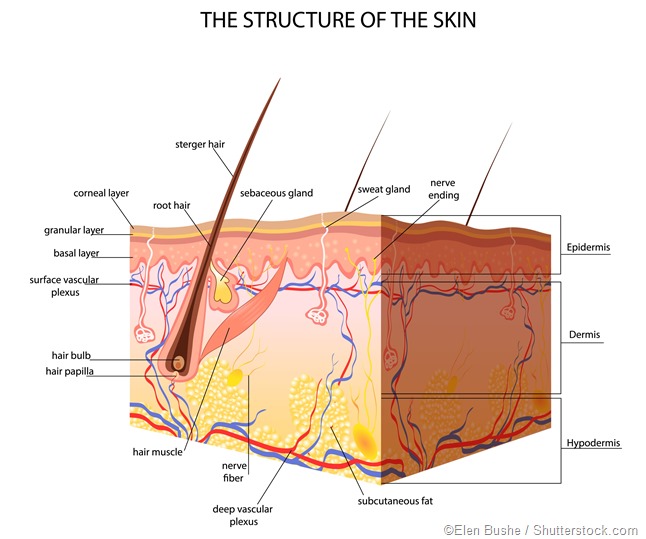The subcutaneous tissue, also known as the hypodermis or superficial fascia, is the layer of tissue that underlies the skin. The terms originate from subcutaneous in Latin and hypoderm in Greek, both of which mean “beneath the skin,” as it is the deepest layer that rests just above the deep fascia.

Structure
The subcutaneous tissue is composed of subcutaneous fat and various other types of cells. It is thickest in areas of the body such as the buttocks, palms, and soles of the feet.
Subcutaneous fat is the most widely distributed layer of subcutaneous tissue and is made up of adipocytes. The adipocytes group together to form lobules, which are separated by connective tissue.
The number of adipocytes in the subcutaneous tissue varies with the area of the body, whereas the size of the individual cells depends on the nutrition of the person. Fat is present in all areas of the body, except the eyelids, clitoris, scrotum, penis and much of the pinna.
Other components of the subcutaneous tissue include:
- Fibrous bands: to anchor the skin to the deep fascia
- Collagen and elastin fibers: to connect the subcutaneous tissue to the dermis
- Lymphatic vessels: to connect the dermis to the lymphatic system
- Nerves: to connect the dermis and free nerve endings in the subcutaneous tissue to the nervous system
- Blood vessels: to connect the dermis to the circulation of blood
- Bursae: to facilitate the smooth movement of skin over joints in the body
- Sweat glands and mammary glands
- Ruffini and Pacinian corpuscles
- Panniculus carnosus
- Hair follicle roots
- Mast cells
Function
The subcutaneous tissue layer of skin plays a number of important roles in the body, as outlined below.
Of particular importance, it connects the dermis to the muscles and bones in the body with the help of specialized connective tissue. It also assists the function of the dermis by providing support to the blood vessels, lymphatic vessels, nerves, and glands that pass through it to reach the dermis.
The subcutaneous tissue is essential because of its role in padding the body. This enables it to protect the bones, muscles, and organs under the skin from physical damage. It does this by storing excess fat around the body in the subcutaneous layer, to cushion the body and protect it from injury.
Additionally, the subcutaneous tissue helps to regulate the temperature of the body. It is able to do this as it provides insulation to the body to prevent overheating or cooling from the environmental heat, which is a process known as thermoregulation.
References
- https://www.aad.org/public/kids/skin/the-layers-of-your-skin
- http://www.sciencedirect.com/science/article/pii/S009167490400332X
- http://www.ncbi.nlm.nih.gov/pubmed/3602174
- http://link.springer.com/chapter/10.1007%2F978-3-540-28163-4_2#page-1
Further Reading